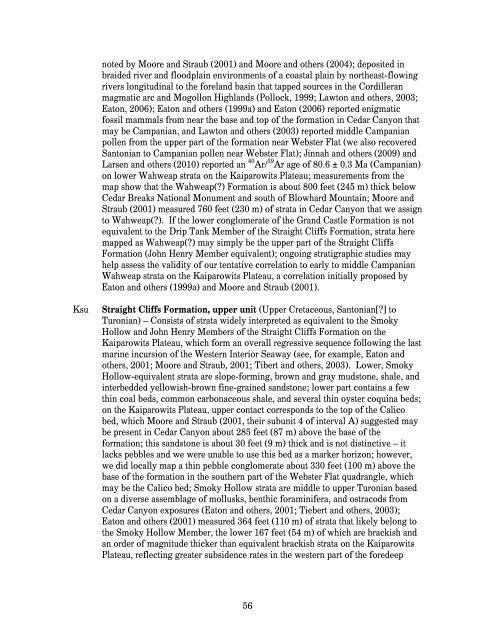Interim Geologic Map of the West Part of - Utah Geological Survey
Interim Geologic Map of the West Part of - Utah Geological Survey
Interim Geologic Map of the West Part of - Utah Geological Survey
You also want an ePaper? Increase the reach of your titles
YUMPU automatically turns print PDFs into web optimized ePapers that Google loves.
noted by Moore and Straub (2001) and Moore and o<strong>the</strong>rs (2004); deposited inbraided river and floodplain environments <strong>of</strong> a coastal plain by nor<strong>the</strong>ast-flowingrivers longitudinal to <strong>the</strong> foreland basin that tapped sources in <strong>the</strong> Cordilleranmagmatic arc and Mogollon Highlands (Pollock, 1999; Lawton and o<strong>the</strong>rs, 2003;Eaton, 2006); Eaton and o<strong>the</strong>rs (1999a) and Eaton (2006) reported enigmaticfossil mammals from near <strong>the</strong> base and top <strong>of</strong> <strong>the</strong> formation in Cedar Canyon thatmay be Campanian, and Lawton and o<strong>the</strong>rs (2003) reported middle Campanianpollen from <strong>the</strong> upper part <strong>of</strong> <strong>the</strong> formation near Webster Flat (we also recoveredSantonian to Campanian pollen near Webster Flat); Jinnah and o<strong>the</strong>rs (2009) andLarsen and o<strong>the</strong>rs (2010) reported an 40 Ar/ 39 Ar age <strong>of</strong> 80.6 ± 0.3 Ma (Campanian)on lower Wahweap strata on <strong>the</strong> Kaiparowits Plateau; measurements from <strong>the</strong>map show that <strong>the</strong> Wahweap(?) Formation is about 800 feet (245 m) thick belowCedar Breaks National Monument and south <strong>of</strong> Blowhard Mountain; Moore andStraub (2001) measured 760 feet (230 m) <strong>of</strong> strata in Cedar Canyon that we assignto Wahweap(?). If <strong>the</strong> lower conglomerate <strong>of</strong> <strong>the</strong> Grand Castle Formation is notequivalent to <strong>the</strong> Drip Tank Member <strong>of</strong> <strong>the</strong> Straight Cliffs Formation, strata heremapped as Wahweap(?) may simply be <strong>the</strong> upper part <strong>of</strong> <strong>the</strong> Straight CliffsFormation (John Henry Member equivalent); ongoing stratigraphic studies mayhelp assess <strong>the</strong> validity <strong>of</strong> our tentative correlation to early to middle CampanianWahweap strata on <strong>the</strong> Kaiparowits Plateau, a correlation initially proposed byEaton and o<strong>the</strong>rs (1999a) and Moore and Straub (2001).KsuStraight Cliffs Formation, upper unit (Upper Cretaceous, Santonian[?] toTuronian) – Consists <strong>of</strong> strata widely interpreted as equivalent to <strong>the</strong> SmokyHollow and John Henry Members <strong>of</strong> <strong>the</strong> Straight Cliffs Formation on <strong>the</strong>Kaiparowits Plateau, which form an overall regressive sequence following <strong>the</strong> lastmarine incursion <strong>of</strong> <strong>the</strong> <strong>West</strong>ern Interior Seaway (see, for example, Eaton ando<strong>the</strong>rs, 2001; Moore and Straub, 2001; Tibert and o<strong>the</strong>rs, 2003). Lower, SmokyHollow-equivalent strata are slope-forming, brown and gray mudstone, shale, andinterbedded yellowish-brown fine-grained sandstone; lower part contains a fewthin coal beds, common carbonaceous shale, and several thin oyster coquina beds;on <strong>the</strong> Kaiparowits Plateau, upper contact corresponds to <strong>the</strong> top <strong>of</strong> <strong>the</strong> Calicobed, which Moore and Straub (2001, <strong>the</strong>ir subunit 4 <strong>of</strong> interval A) suggested maybe present in Cedar Canyon about 285 feet (87 m) above <strong>the</strong> base <strong>of</strong> <strong>the</strong>formation; this sandstone is about 30 feet (9 m) thick and is not distinctive – itlacks pebbles and we were unable to use this bed as a marker horizon; however,we did locally map a thin pebble conglomerate about 330 feet (100 m) above <strong>the</strong>base <strong>of</strong> <strong>the</strong> formation in <strong>the</strong> sou<strong>the</strong>rn part <strong>of</strong> <strong>the</strong> Webster Flat quadrangle, whichmay be <strong>the</strong> Calico bed; Smoky Hollow strata are middle to upper Turonian basedon a diverse assemblage <strong>of</strong> mollusks, benthic foraminifera, and ostracods fromCedar Canyon exposures (Eaton and o<strong>the</strong>rs, 2001; Tiebert and o<strong>the</strong>rs, 2003);Eaton and o<strong>the</strong>rs (2001) measured 364 feet (110 m) <strong>of</strong> strata that likely belong to<strong>the</strong> Smoky Hollow Member, <strong>the</strong> lower 167 feet (54 m) <strong>of</strong> which are brackish andan order <strong>of</strong> magnitude thicker than equivalent brackish strata on <strong>the</strong> KaiparowitsPlateau, reflecting greater subsidence rates in <strong>the</strong> western part <strong>of</strong> <strong>the</strong> foredeep56
















